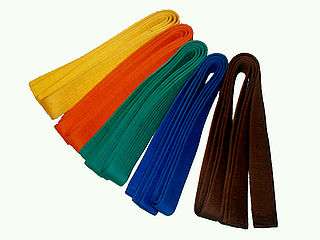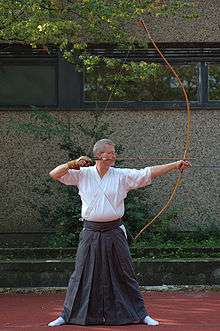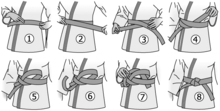Obi (martial arts)
Many Japanese martial arts feature an obi (Japanese: 帯) as part of their exercise outfit. Such an obi is often made of thick cotton and is about 5 cm wide. The martial arts obi are most often worn in the koma-musubi knot (square knot); in practice where a hakama is worn, the obi is tied in other ways.


In many martial arts, the colour of the obi signifies the wearer's skill level. Usually the colours start from white for beginners and end in black or red-and-white for masters.
Aikido
Unlike in many other martial arts, adult practitioners of aikido do not wear coloured obis,[1] though in some schools different colour codes have been formed,[1] especially for children. The children's obis range from white for beginner level to 7th kyū, other colours for the rest of the kyū levels, and black for levels 1st dan and up.[2]
In some aikido schools, wearing a hakama is a privilege earned by reaching the first dan level. In other schools, all practitioners may wear a hakama. After taking up using a hakama, the colour of obi does not matter since it will be covered by the hakama.[2]
Example of colour range in aikido
Below is a typical example of obi colours per level in aikido:[1]
| Level | Obi colour |
|---|---|
| 6th kyū | yellow |
| 5th kyū | orange |
| 4th kyū | green |
| 3rd kyū | blue |
| 2nd and 1st kyū | brown |
| 1st-3rd dan | black |
| 4th-9th dan | black and red, or white and red |
| 10th dan | dark blue |
However, aikido schools worldwide may use their own systems with little reference to other schools save the use of a black belt for at least some dan grades.
Bujinkan Budō Taijutsu
The Bujinkan (武神館) makes use of only a limited set of belt colours, however there are also different associated uniform emblems or wappen (ワッペン), the style of which varies dependent on the grade of the Budoka. Unlike many other martial arts, the number of Dan grades extends to Jūgodan (15th Dan), and practitioners at this grade of may also be gifted the status of Dai Shihan (大師範, roughly translated as "senior instructor") by the Sōke[3] This title also comes with its own wappen style featuring a purple background.
| Level | Obi colour |
|---|---|
| Without Grade (Mukyū) | White |
| Kyū Grades | Green |
| Dan Grades | Black |
Ninjutsu
Ninja obi are required within JNF and WNF.
| Obi colour | Ninjutsu Level |
|---|---|
| White | |
| Silver | |
| Yellow | 2nd dan |
| Orange | 2nd dan |
| Red | |
| Gold | 8 kyu |
| Pale Orange | 2nd dan and 8-5 kyu |
| Brown | 5th dan and 5 kyu |
| Green | 2nd dan |
| Blue, Purple | 2nd dan and 5 kyu |
| Black | 4th dan and 10 kyu |
| Dark Blue | 3rd dan and 10- 15-15 kyu |
Atarashii naginata
The outfit used for Atarashii naginata practice includes a hakama that covers the obi. The obi is always white; its colour has no significance beyond simply blending in with the white keikogi worn when practicing the art.
Iaido
The outfit worn to iaido practise includes a hakama, which is worn over the top of the obi, which fastens the keikogi. The obi colour has no meaning in iaido,[4] and is usually chosen to blend in with the kimono or hakama worn by the practitioner.
Jōdō
The outfit used for jōdō practise includes a hakama that covers the obi. The colour of the obi has no significance.
Judo
Below are the colours of obis worn for judo practise. Junior practitioners have a different colour range.[5] There are also other colour ranges used worldwide.
| Level | Obi colour |
|---|---|
| Beginners | White |
| 5th kyū | Yellow |
| 4th kyū | Orange |
| 3rd kyū | Green |
| 2nd kyū | Blue |
| 1st kyū | Brown |
| 1st - 5th dan | Black |
| 6th - 8th dan | Red and White |
| 9th and 10th dan | Red |
Ju-Jitsu
The colours for obis used for Ju-Jitsu practise range as follows:[6]
| Level | Obi colour |
|---|---|
| beginners | red |
| 10th – 8th kyū | red |
| 7th kyū | white with a red stripe |
| 6th kyū | yellow |
| 5th kyū | orange |
| 4th kyū | green |
| 3rd kyū | blue |
| 2nd kyū | violet |
| 1st kyū | brown |
| Shōdan-ho | brown and black ("temporary black") |
| 1st - 5th dan | black |
| 6th dan and higher | red and white |
Different Ju-Jitsu federations use different colours. An alternative is shown below.
| Level | Obi Colour |
|---|---|
| beginners | red |
| 8th kyū | white |
| 7th kyū | yellow |
| 6th kyū | orange |
| 5th kyū | green |
| 4th kyū | blue |
| 3rd kyū | purple |
| 2nd kyū | brown and white |
| 1st kyū | brown |
| 1st - 5th dan | black |
Jūkendō
The outfit used for Jūkendō practise includes a hakama that covers the obi. The colour of the obi has no significance.
Karate
Kyokushin
The obis used in the Kyokushin style range in colour as follows:[7]
| Level | Obi colour |
|---|---|
| 10th kyū | white |
| 9th kyū | orange |
| 8th kyū | blue |
| 7th kyū | blue and yellow stripe |
| 6th kyū | yellow |
| 5th kyū | yellow and green stripe |
| 4th kyū | green |
| 3rd kyū | green and brown stripe |
| 2nd kyū | brown |
| 1st kyū | brown and black stripe |
| 1st - 10th dan | black |
Wadō-ryū
The obis used in the wadō-ryū style range in colour as follows:[8]
| Level | Obi colour |
|---|---|
| beginners | white |
| Turkos 10th kyū | |
| 9th kyū | Red |
| 8th kyū | yellow |
| 7th kyū | orange |
| 6th kyū | green |
| 5th kyū | blue |
| 4th kyū | violet |
| 3rd - 1st kyū | brown |
| 1st dan and higher | black |
Shotokan
The obis used in the shotokan KUGB style range in colour as follows:[9]
| Level | Obi colour |
|---|---|
| 10th kyū | white |
| 9th kyū | orange |
| 8th kyū | red |
| 7th kyū | yellow |
| 6th kyū | green |
| 5th kyū | purple (violet) |
| 4th kyū | purple (violet) and one white stripe |
| 3rd kyū | brown |
| 2nd kyū | brown and one white stripe |
| 1st kyū | brown and two white stripes |
| 1st - 10th dan | black |
Shitō-ryū
The obis used in the Shitō-ryū style range in colour as follows:[10]
| Level | Obi colour |
|---|---|
| 10th kyū | White |
| 9th kyū | Yellow/White |
| 8th kyū | Yellow |
| 7th kyū | Orange |
| 6th kyū | Green |
| 5th kyū | Blue |
| 4th kyū | Purple |
| 3rd kyū | Brown |
| 2nd kyū | Brown (1 white stripe) |
| 1st kyū | Brown (2 white stripes) |
| 1st-10th dan | black |
| 10th-15th dan | blue |
Kendo
The outfit used for kendo practise includes a hakama that covers the kendogi. An obi is optional; if worn, its colour has no significance.[11]
Kyūdō
The outfit used for kyūdō practise includes a hakama that covers the obi. The colour of the obi has no significance.
T'ai Chi Ch'uan
The outfit used for T'ai Chi is either loose-fitting, comfortable clothing or the same kind of uniform as Kung Fu. Some schools also include a coloured sash, but no standard for their order has been established. They commonly follow the same basic rules as Kung Fu, beginning with white, yellow, orange, purple, blue, green, brown and black. Some may skip a rank, others may subdivide them with a stripe or tag.
References
- Bennett, Gary (1997). Aikido techniques & tactics. Human Kinetics Publisher. ISBN 0-88011-598-X.
- Goodman, Fay (1998). The Ultimate Book of Martial Arts. Lorenz Books. ISBN 1-85967-778-9.
Notes
- Bennett p. 8-11
- Goodman s. 70
- Cousergue, Arnaud (2015-05-25). "What Type Of Shihan Are You?". THOUGHTS ON BUDO.
- Goodman p. 230-231
- Goodman s. 134
- Goodman s. 101
- "Graduação Kyokushin". www.kyokushin.com.br. Retrieved 2020-03-01.
- Goodman s. 32
- Goodman s. 52
- http://shitokai.com/cyber-academy/shitoryu-karate-do-grading-syllabuses
- Goodman s. 214. This was mentioned in Sword Art Online when Kirito and his sister fought using Kendo.
